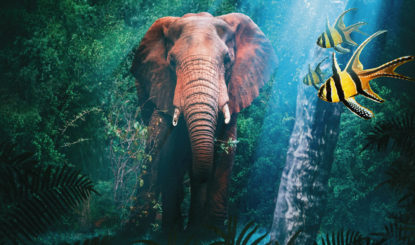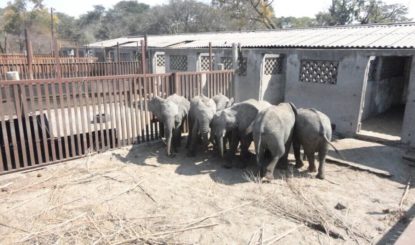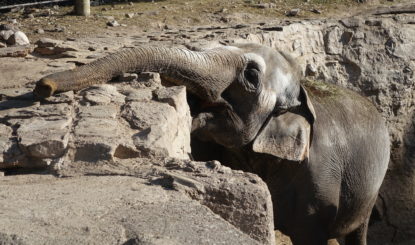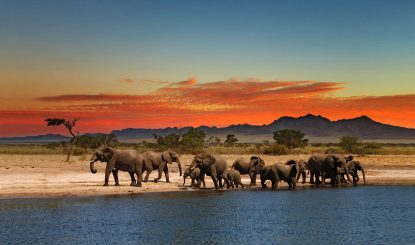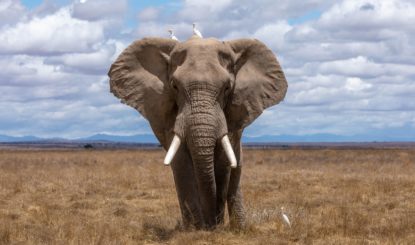Open the international ivory trade…or else!
Southern African nations intimidate, bully and threaten the rest of Africa (and the world) in rejecting the full protection of African elephants.
GENEVA. Extraordinary scenes took place on Thursday at the 18th Conference of the Parties (CoP18) Convention on International Trade in Endangered Species of Wild Fauna and Flora (CITES) as one by one southern African nations dropped established decorum for short-tempered outbursts attacking other African nations for trying to provide the full protection for African elephants under international law and rejecting their own proposals to open the international trade in ivory.
Southern Africa versus the rest
A proposal put forward by Burkina Faso, Côte d’Ivoire, Gabon, Kenya, Liberia, Niger, Nigeria, Sudan, Syrian Arab Republic and Togo and backed by the 32 African countries of the African Elephant Coalition (AEC) called for all African elephants be placed on Appendix I, which ensures that no commercial trade of elephants or their body parts would in the future be permitted.
Elephants in Botswana, Namibia, South Africa and Zimbabwe are currently listed under Appendix II. These countries have been allowed to sell stockpiled ivory in the past, with dire consequences to elephants. Ever since the sales (in 1999 and 2008) of more than 150 tons of ivory to Japan and China, Africa has lost one-third of its entire population due to poaching for elephant tusks.
But South Africa said it was “affronted” and found it “incomprehensible” that other African nations dare table such a proposal. South Africa, along with other southern African nations earlier had their own attempt to sell their ivory stockpiles resolutely blocked by other CITES Parties, while a proposal by Zambia to downlist its elephant populations was also soundly rejected.
An infuriated Minister of Environment and Tourism for Botswana, Kitso Mokaila, called it “ridiculous and inconceivable”. Mokaila and his southern African counterparts repeatedly attacked other African nations for their poor governance and conservation records and for daring to give an endangered species the highest protection under international law. Mokaila openly threatened other Parties not to support the proposal.
The country’s chief of delegation said that other African were against the spirit of the Conventions by making “arguments with false allegation” and that their interventions during the debate were “not factually based, and not useful, particularly to atmosphere in which this discussion.” This was remarkable accusation given the hostile atmosphere was perpetuated by the southern Africans while other African nations maintained the soberness more in line with the convention.
Kenya for example, debated Zambia’s proposal to downlist based purely on biological criteria as provided by CITES documents and annexes as well as providing statistical data from academic research, scientific surveys and information as provided by the IUCN and other inter-governmental and non-governmental organizations.
Selling ivory to support rural livelihoods?
Much of the vitriolic justification to trade in ivory centred around the livelihoods of impoverished rural communities. The arguments from southern Africa were based on a premise that the sales of ivory would contribute directly to the economic upliftment of the poor.
Zimbabwe’s delegation told the committee that its people are “walking barefooted, with no schools, no roads, no drinking water.” The country’s delegation believes the sale of its stockpile of ivory is the solution to poverty alleviation.
Botswana was of the same opinion: “You cannot be a good zoo and not be paid to be a good zookeeper,” said Mokaila in bizarre rant while South Africa’s delegation stated that the “proceeds of trade would be used exclusively for elephant conservation, community conservation and community development programs.” South Africa bemoaned that CITES was being “punitive” and “settling a score against southern African countries” and (referring to Zambia’s proposal) was not solving “real problems in situations where we are talking a least developed country.”
Namibia’s Minister of Environment Pohamba Shifeta argued that the “future threat to elephant population is not sustainable utilization but rather local communities retaliating if they do not benefit from destructive elephants.”
However, Alejandro Nadal, a renowned economist from El Colegio de Mexico here at the conference says all these statements are groundless. “These proclamations on the role of wildlife trade on elephant conservation and livelihoods and poverty alleviation are unjustified,” he said.
Nadal’s calculations show that even if all the ivory stocks in these countries were sold today at current market prices, and all of these resources were allocated to combat poverty, this would not make a dent on the lives of rural communities.
For example, Botswana made around US$7-million dollars from its sale of 43 tons of stockpile ivory in 2008. Given that there is, at best, around 500,000 rural villagers living in northern Botswana where elephants exist, this would equate to a one-off handout of just fourteen dollars per person. That does not even compare to the US$23-billion made off the proceeds of living elephants from leisure tourism in the year 2018, a figure that has an expected growth of 3,4% per annum.
“Poverty and social marginalization are macroeconomic problems,” Nadal points out. “They are related to economy-wide forces and long-term trends. The resources from selling the accumulated stock of ivory are orders of magnitude below what would be needed to even begin to make a difference. It is disingenuous to pretend that ivory sales will make a significant and durable difference in improving welfare of local populations or alleviating poverty.”
Nadal thinks the justifications are laughable. “Stating that these resources will be constructively used for the benefit of communities is misleading. The needs of rural populations will not disappear next year just because a government agency sells the ivory stocks this year.”
Elephant crisis
Elephants are in crisis with at least 20,000 being illegally killed each year for their ivory. On average around 55 elephants are poached every day in Africa, that’s roughly one every 26 minutes.
During the debate on Thursday, Kenya’s head of delegation pointed to factual analysis that shows a clear correlation between the 2008 ivory stockpile sales and an increase in illegal trade and poaching. He also noted that there has been an estimated increase of 71 percent in ivory smuggling out of Africa following the 2008 stockpile sales.
However, given the bluster and bludgeon from the southern African states which ended up putting the proposal to uplist all elephants on Appendix I on ice, the carnage throughout the continent is set to continue unabated.
